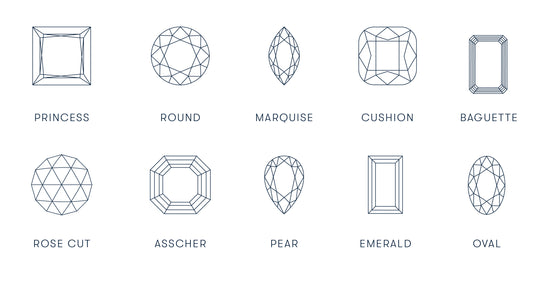We know that selecting a piece of jewellery can be daunting, and even more so when designing completely from scratch. Jewellery jargon and an abundance of choice are partly responsible. The Lylie’s Sustainable Jewellery team decided to compile this gemstone shape guide, in the hope that it will make you feel more at ease when selecting our manmade gemstones and recycled antique diamonds.
Princess

With a modern look and clean lines, this is the second most popular gemstone shape. Its pyramidal shape with four bevelled sides creates a large amount of light dispersion that translates into a lot of sparkle. Light, transparent gemstones, like our antique diamonds, tend to show the greatest sparkle.
Round

This is the most popular gemstone shape, frequently used as a solitaire (single stone) in engagement rings, earrings or pendants. It is the stone shape with the highest brilliance, meaning white sparkle, and greatest fire, meaning rainbow sparkle.
Marquise

This stone was created following Louis XV’s request in 1745 for a diamond that resembled the smile of his mistress, the Marquise de Pompadour. It is also known as a ‘navette,' little boat, owing to its similarity to the hull of a small boat. Its elongated shape makes the stone appear larger and the finger longer.
Cushion

Most often square but can be rectangular, this stone acquired its name through its resemblance to its namesake. It was the most popular shape until the 20th century but has once again gained popularity with an increasing number of people opting for it in engagement rings. It is known for its fire (rainbow sparkle), referring to its capacity to disperse a band of spectral colours.
Baguette

The baguette shape was created sometime between the 1920s-1930s during the Art Deco and Art Nouveau movements. It has clean lines, a modern, geometric look and is designed to maximise clarity over fire (rainbow sparkle) and brilliance (white sparkle). Whilst similar to an emerald shape (see below), a baguette stone is slightly narrower. It is often used as an accent stone or in eternity style wedding bands due to the relative ease of setting it alongside others.
Rose Cut

The cut dates back to the 16th century and describes a flat back gemstone with a faceted dome top. It derives its name from the facets’ resemblance to petals unfolding in a rose bud. Admired throughout the Georgian and Victorian era, the cut refers to the arrangements of the gemstone’s facets rather than its shape, meaning you could have a rose cut round (the most popular), or a rose cut pear, a rose cut cushion and so on.
Asscher

This stone was developed in the 20th century, at the birth of the Art Deco movement. The step cut focuses your attention into its centre, generating an amazing optical illusion known as the ‘Hall of Mirrors’. It maximises stone clarity over fire (rainbow sparkle) and brilliance (white sparkle).
Pear

A hybrid of a round stone and marquise stone, pear-shaped stones may be set downwards or upwards. They may display a 'bow-tie effect', where light passing through the diamond casts a bow-tie shaped shadow across the central facets of the stone.
Emerald

Originally created for an emerald in the 14th century, this shape is one of the oldest in jewellery history. Its clarity, its capacity to show vivid colours and its 'Hall of Mirrors' effect are its winning features. Like the marquise, baguette, pear and oval (see below), the emerald’s elongated shape flatters the finger.
Oval

The oval shape was invented in the early 1960s. It is a hybrid of a round and marquise-shaped stone, possessing a similar amount of fire (rainbow sparkle) and brilliance (white sparkle) to that of a round, but offering something slightly more unusual, like a marquise. Its drawn out and symmetrical shape can make it appear larger than round stones of a similar weight.
Additional reading - our advice on engagement rings and diamond studs.
Words
Caitlin Astley
Images
Danae Papazymouri












